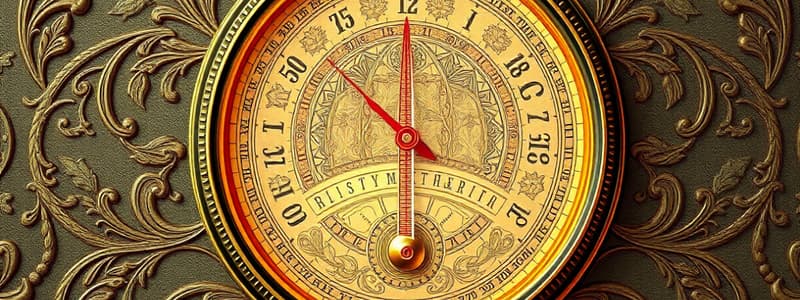Podcast
Questions and Answers
What is the primary benefit of repeating experiments?
What is the primary benefit of repeating experiments?
- Increases the time taken for the experiment
- Improves the presentation of results
- Reduces the influence of random error (correct)
- Allows for measurement of maximum values
Taking the average of multiple trials can help cancel out fluctuations in data.
Taking the average of multiple trials can help cancel out fluctuations in data.
True (A)
What is the average of the values 27.4 s, 26.7 s, and 27.8 s?
What is the average of the values 27.4 s, 26.7 s, and 27.8 s?
27.30 s
Repeating the experiment multiple times leads to a more precise ______.
Repeating the experiment multiple times leads to a more precise ______.
Match the following steps to their descriptions in reducing random error:
Match the following steps to their descriptions in reducing random error:
What is the primary purpose of an ammeter?
What is the primary purpose of an ammeter?
Looking from the right when reading an ammeter will lead to an overestimated current reading.
Looking from the right when reading an ammeter will lead to an overestimated current reading.
What are the two fixed points chosen for marking a thermometer?
What are the two fixed points chosen for marking a thermometer?
o find the temperature ______ using the thread length, the formula is $ = \frac{L_______}{L_{100}} \times (x_{100} - x_0) + x_0$ where L represents the length of the thread at specific temperatures.
o find the temperature ______ using the thread length, the formula is $ = \frac{L_______}{L_{100}} \times (x_{100} - x_0) + x_0$ where L represents the length of the thread at specific temperatures.
Match the following terms with their definitions:
Match the following terms with their definitions:
What is the formula for calculating percentage error?
What is the formula for calculating percentage error?
Random error can be both positive and negative.
Random error can be both positive and negative.
What is the random error for a measuring apparatus with a smallest scale of 0.5 cm?
What is the random error for a measuring apparatus with a smallest scale of 0.5 cm?
The formula for relative error is __________.
The formula for relative error is __________.
Match the measurement tools with their estimated random errors:
Match the measurement tools with their estimated random errors:
What is the SI unit for mass?
What is the SI unit for mass?
The SI prefix 'm' represents a factor of 10 to the power of 12.
The SI prefix 'm' represents a factor of 10 to the power of 12.
What is the derived unit for energy?
What is the derived unit for energy?
What is a characteristic of systematic error?
What is a characteristic of systematic error?
The basic unit of thermodynamic temperature in the SI system is the ______.
The basic unit of thermodynamic temperature in the SI system is the ______.
Parallax error occurs when the scale is read from a direction that is perpendicular to the measuring apparatus.
Parallax error occurs when the scale is read from a direction that is perpendicular to the measuring apparatus.
Which of the following instruments is used for measuring volume?
Which of the following instruments is used for measuring volume?
Match the following prefixes with their corresponding factors:
Match the following prefixes with their corresponding factors:
What should be done to eliminate zero error in a measuring apparatus?
What should be done to eliminate zero error in a measuring apparatus?
A non-zero reading when a zero reading is expected is called ________ error.
A non-zero reading when a zero reading is expected is called ________ error.
The SI derived unit for frequency is called a newton.
The SI derived unit for frequency is called a newton.
Match the following error types with their descriptions:
Match the following error types with their descriptions:
1 kilometre is equivalent to ______ metres.
1 kilometre is equivalent to ______ metres.
Which of the following instruments is used to measure mass?
Which of the following instruments is used to measure mass?
A coloured alcohol thermometer is used to measure time.
A coloured alcohol thermometer is used to measure time.
What unit is used to measure temperature?
What unit is used to measure temperature?
The scale of a ruler should be read __________ above.
The scale of a ruler should be read __________ above.
Match the following measurement instruments with their respective measurements:
Match the following measurement instruments with their respective measurements:
Flashcards are hidden until you start studying
Study Notes
Reducing Random Error
- Repeating experiments multiple times yields a more precise average, reducing the influence of random error.
- Multiple measurements can be averaged to cancel out fluctuations caused by random errors and improve the accuracy of the experiment.
Ammeter
- Ammeters measure electric current.
- Parallax error can occur when reading an ammeter due to viewing it from an angle.
- Overestimation occurs when viewing from the left, while underestimation occurs when viewing from the right.
- To avoid parallax error, view the ammeter from vertically above.
Thermometer
- Thermometers utilize two fixed points for calibration: pure melting ice (0°C) and pure boiling water (100°C).
- The space between these fixed points is divided into 100 equal scales, each representing 1°C.
- The equation to find the temperature (T) is: $T = \frac{L_T}{L_{100}} \times(x_{100} - x_0) + x_0$, where:
- $L_T$ is the length of the thermometer's thread at temperature T.
- $L_{100}$ is the length of the thread at 100°C.
- $x_0$ is the position of the thread at 0°C.
- $x_{100}$ is the position of the thread at 100°C.
International System of Units (SI)
- SI base units are the fundamental units of measurement.
- Common SI base units include:
- Meter (m) for length
- Kilogram (kg) for mass
- Second (s) for time
- Ampere (A) for electric current
- Kelvin (K) for thermodynamic temperature
- Mole (mol) for the amount of substance
- Candela (cd) for luminous intensity.
- SI prefixes are used to express very large or very small quantities.
- Some common SI prefixes and their corresponding factors include:
- kilo (k): 10^3
- mega (M): 10^6
- milli (m): 10^-3
- micro (µ): 10^-6
- SI derived units are derived from combinations of SI base units.
- Some common SI derived units include:
- Hertz (Hz) for frequency
- Newton (N) for force
- Pascal (Pa) for pressure
- Joule (J) for energy
- Watt (W) for power.
Error Estimation
- Random error is inherent in all measurements and is caused by the limitations of measuring instruments.
- Random error can be minimized by repeating measurements and taking the average.
- Random error is estimated by dividing the smallest scale of the apparatus by 2.
- Relative error expresses random error in relation to the measured value.
- Percentage error is the relative error multiplied by 100%.
- Systematic errors are caused by faulty experimental design or instrument calibration.
- Systematic errors shift all measurements in the same direction, either higher or lower.
- Parallax error is a type of systematic error that occurs when the observer's eye is not perpendicular to the scale.
- Zero error occurs when the instrument gives a non-zero reading when it should be zero.
Instruments and Measurements
- Mass is measured using an electronic balance, with units of milligram (mg), gram (g), and kilogram (kg).
- Temperature is measured using a colored alcohol thermometer or a mercury thermometer, with the unit being degree Celsius (°C).
- Time is measured using a stopwatch with units of seconds (s), minutes (min), and hours (h).
- Accurate readings require observing proper techniques for each instrument.
- For rulers, read the scale vertically above.
- For measuring cylinders, ensure your eye level is at the same level as the bottom of the meniscus.
- For thermometers, align your eye level with the liquid level inside the thermometer.
Reducing Error
- Repeated measurements can be used to reduce random error.
- Averaging multiple measurements reduces the impact of fluctuations caused by random errors.
Studying That Suits You
Use AI to generate personalized quizzes and flashcards to suit your learning preferences.




